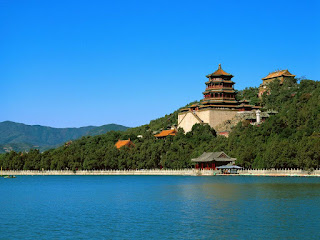I went to the summer home of the emperors.
The massive mega-estate is in North West Beijing, and is kind of a hike to get to. Beijing is very big and spread out, like Los Angeles. But it was worth the trek to see this awesome royal residence for myself.
The palace sits on Longevity Hill, which overlooks a man-made lake. It's one mile long and was initially built in 1153 by the fourth ruler in the Jin dynasty. But over time, every Chinese ruler after him had their teams to expand it, cultivate, and renovate the grounds to absolute perfection.
It was burned down twice in wars, but was always rebuilt.
The Summer Imperial Palace, as it is officially called, is a series of grand pavilions, halls, palaces, temples, gardens and bridges.
 |
| A professional picture of Summer Palace. |
The palace was used by every presiding emperor and his wife. And his top concubines #1, #2 and #3 got to come along too, as well as any children they had with the emperor.
Important office staff were rounded up too, and together they would all come here to chill in the summers, or for birthday weekends, or to host international dignitaries and other special guests, or to just getaway from their (hard?) lives.
 |
| Stunning. Professional photo. |
The design is based on a legend in Chinese mythology.
 |
| Map of Summer Palace, 1888. |
Some important business meetings and discussion would take place while the emperor was relaxing here - things like court proceedings and military briefings, but largely, this summer villa was a place to have party and have fun.
The estate is now a public park. Here are my photos of the day I went.
 |
| Hall of Benevolence and Longevity. There's actually furniture and light fixtures that the last emperor used in many of the halls. They all still work. |
 |
| Lotus flowers. I found out from a local while at the palace the reason the Chinese love their state flower is because it grows in dirty muddy waters, but blossoms so pretty. |
 |
| Pavillon of Precious Clouds. |
 |
| Nowadays, Senior Citizens are let into the park for free. A bunch of regulars come here everyday to exercise, sing and dance. |
I heard many concubine urban tales on my visit to Summer Palace. Apparently, they had to always watch their backs because they were malicious and vicious to each other. They were always plotting to take each other out, and/or to kill the emperor's wife.
Each night, the concubines would get massaged, receive mani/pedi's, and have their hair and make-up done, and then they'd wait to see if the emperor would choose them. He usually didn't do the choosing - his assistant always did, and that admin took copious notes about each woman.
If you did not get chosen after a few presentations, you would get pushed out of rotation and be downgraded housekeeper. This happened every day. Many emperors had hundreds, some had thousands, of concubines.
 |
| Seniors were singing old traditional Chinese songs. It sounded like Alabama twang. |
 |
| Lotus flowers. |
 |
| This place is old. Man, if these walls could talk. |
The biggest scandal about Summer Palace is Empress Dowager Ci Xi (pronounced Cee- She). At age 17, in 1852, she entered the Forbidden City as "Honorable Person Lan," concubine of the 5th rank. She was promoted to "Royal Concubine Yi" and after giving birth to a son, and she became "Imperial Concubine."
The Emperor died in 1861 leaving his only son, 5-years old, as heir to his throne. Ci Xi, his mother, was elevated to "Holy Mother Empress Dowager" (over the widow!!!) and as his guardian, she became Regent.
Soon, she staged a coup d'etat and seized political power. While she was somewhat educated (she taught herself to read and write at a young age) she was ignorant of the world at large and resisted all attempts to modernize China. Her 50-year reign was founded on the principles of Confucian teachings. She was the effective ruler of China during the reign of two emperors, her son and her nephew (whom she put into office too).
On the occassion of her 60th birthday in 1895, the Empress Dowager Ci Xi renovated the Summer Palace, largely to the decadence of what it is now. To finance this massive undertaking she used funds slated for the Imperial Navy to the dismay of many. Empress Dowager Ci Xi died in 1909 at age 74.
 |
| The long corridor. These overhead beams tell a sequential story. Everything is hand painted. The stories are all about boys, no girls are painted. |
 |
| The stonework on the ground is from Ci Xi's era. |
 |
I stepped on this and looked down, and realized that these ground gutter gates are all over Beijing. It means "Happiness. Long Life. Longevity."
|
 |
| Garden of Harmonious Pleasures. |
 |
| People stood in long lines to take a cruise around the lake. |
 |
| Those boats have dragon heads. Pretty cool. |
 |
| The man-made lake is called Kunming Lake. |
 |
| Marble boat. Nice. This section of the villa is called Suzhou Street. Remember I told you before, Suzhou is the birthplace of many things Chinese :-) |
 |
| My favorite trees in China! |
 |
| So peaceful. |
 |
| One of 15 bridges on the grounds. |
 |
| Yeah, pretty much, I want a summer villa like this too. |
The visit was great. The weather was hazy, but the pictures came out okay.
~SS






















No comments:
Post a Comment